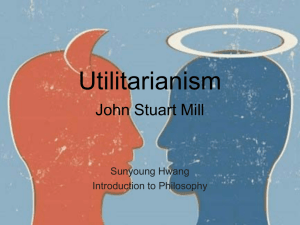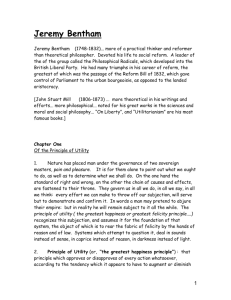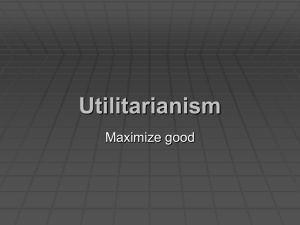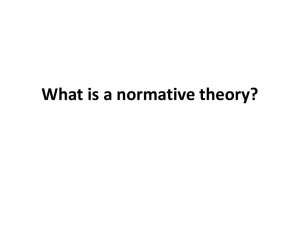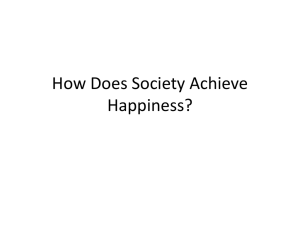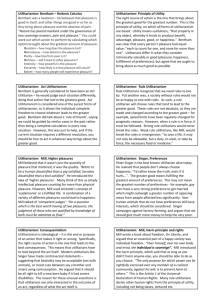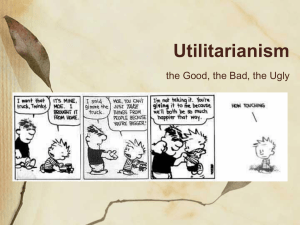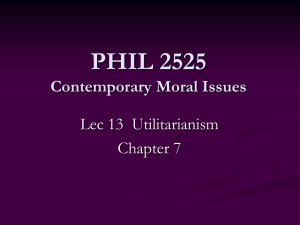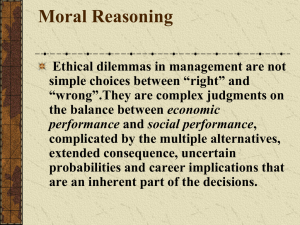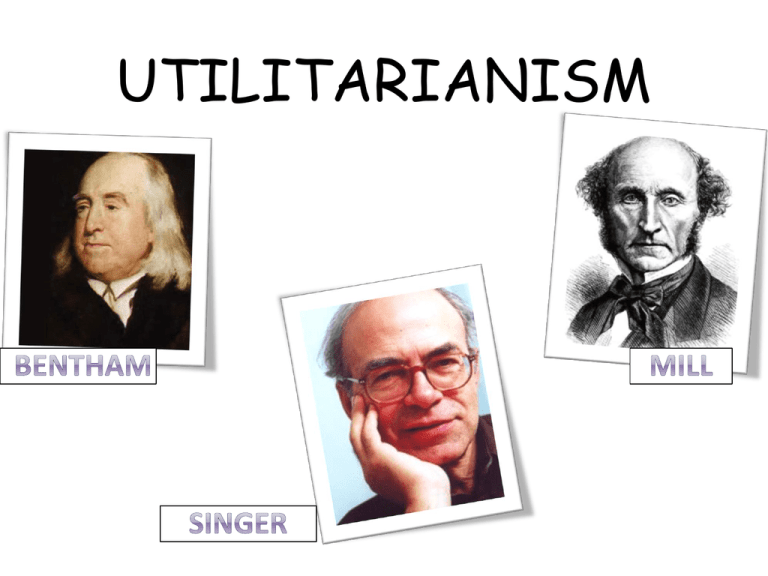
UTILITARIANISM
Introduction
• This is a viewpoint independent of religious belief
(though religious people can use it).
• It is focussed on the consequences of the action.
• There are different types of Utilitarianism: Act,
Rule and Preference.
• Utilitarianism is based on the Principle of Utility
or the greatest good.
Is it wrong to kill a baby?
• You have invented a time
machine!
• You press the button and
find yourself alone in a
room with baby Hitler.
• What are some of the
possible consequences if he
chose to kill the baby…
• If it stopped WW2 would
it make it right?
Making Ethical Judgments in
Utilitarianism
• Utilitarianism says that the
Result or the Consequence of an
Act is the real measure of
whether it is good or bad.
• This theory emphasizes
Ends over Means.
• It is therefore, a
consequentialist ethical theory.
• A naval warship is in a battle. It receives a
severe hit to the engineering section and a
fire breaks out. If the fire continues, the
ship’s munitions could explode, killing the
whole crew.
• The captain can use a fast-acting fire
extinguisher that would result in the blasts
of steam putting out the fire, but this will
kill the 5 men trapped in engineering…
For the greater good……..
Utilitarianism is an
ethical theory behind
the justification ‘for
the greater good’
Theory focuses on the
‘greatest happiness
for the greatest
number’
Utilitarianism
Utilitarianism was devised by Jeremy
Bentham. (1758 – 1832)
He was born in London at a time of
great scientific and social change.
With revolutions in France and America
demands were being made for human
rights and greater democracy.
Bentham worked on legal reform and
wrote The principles of Morals and
Legislation 1789
Jeremy Bentham 1748-1832
• Was a child, received his degree
at 15 years old.
• Concerned with social conditions
of his time and was a political
philosopher and a political radical.
• Wrote ‘The Principles of morals
and legislation’ in 1789 in which he
proposed his ethical theory of
utilitarianism.
• His drive and belief in equality
was the inspiration for the
opening of UCL in London
• His preserved body is sill there in
a wooden cabinet.
Utilitarianism
We can divide his theory into three
parts:
1. Motivation - His view on what drove
human beings and what goodness and
badness was about
2. The principle of utility (usefulness) which is his moral rule.
3. The hedonic calculus - which is his
system for measuring how good or
bad a consequence is.
Issue: School Uniform
• In many schools, uniform is
a rule.
• What are the beneficial
consequences of school
uniform? Who for?
• Could school uniform be
seen as leading to the
greatest good for the
greatest number?
• Would a Utilitarian support
the wearing of school
uniform?
Bentham’s theory of motivation
Human beings are motivated by
pleasure and pain.
He is thus a Hedonist. He
believes that pleasure is the
ultimate motivation.
Bentham’s theory of motivation
All humans pursue pleasure and
seek to avoid pain.
This is a moral fact because
pleasure and pain identify what
is a good or a bad action
For humans the sole good is
pleasure and the sole evil is pain.
For this reason Bentham’s
Utilitarianism is called ‘Hedonic
Utilitarianism’.
The principle of utility
Once Bentham identified pleasure and
pain as the important qualities for
identifying what is moral he developed
the ‘Utility Principle’
The rightness or wrongness of an
action is judged by its utility or
usefulness to produce pleasure.
because pleasure produces a feeling of
happiness it is used interchangeably in
the utility principle.
The action that produces the most
happiness is the most moral.
Hedonic Calculus
The greatest good
• We can shorten this to: “an action
is right if it produces the
greatest good for the greatest
number’
• good is the maximization of
pleasure.
• The more pleasure that an action
produces the better it is.
• the larger the number of people
that an action produces pleasure
for, the better than action is.
The greatest number
This theory is democratic because
pleasure cant be for one person
alone.
When facing a moral dilemma,
Bentham argued that one should
choose to act in such a way that
brings about the maximum possible
happiness for the most people.
However, the possible consequences
of different possible actions must
be measured clearly to establish
which option generates the most
pleasure and the least pain.
The car accident
a Doctor witnesses a car accident.
In the car are three people.
1. A pregnant woman
2. The young woman’s husband
3. The woman’s father.
All have an equal chance of
survival but he can only save two
person in time. One person is
bound to die.
Who does he save and why?
He saves…
The doctor if he was a utilitarian
would save…
The pregnant woman first – this is
because she and the baby would
have the happiness/pleasure of two
people.
The husband would be next
because the happiness of a new
family would outweigh the
happiness of one man.
The old man would be left because
he has had his portion of happiness.
Equal circumstances
• What if the circumstances
are equal.
• Two men are in the car.
• Both are doctors
• Both are GP’s with the same
number of patients in their
surgery.
• Who does he save then?
Thinking Points- Debate
1. Are all actions only good
because they have good
results?
2. Suppose a surgeon could
use the organs of one
healthy patient to save
the lives of several
others. Would the
surgeon be justified in
killing the healthy
patient for the sake of
the others?
Suppose a rape is committed that
is thought to be racially motivated.
Riots are brewing that may result
in many deaths and long term racial
antagonism. You are the police
chief and have recently taken a
man into custody.
Why not frame him? He will be
imprisoned if found guilty and this
will result in peace and safety.
Only you, the innocent man and the
real rapist (who will keep quiet),
will know the truth. What is the
morally right thing to do?
• Sadistic guards torture a wrongly
imprisoned innocent man. What
difficulty does this example pose for
Bentham’s theory?
The Hedonistic Calculus
In the hedonic calculus Bentham considers
1. How strong the pain or pleasure is
2. Whether it is short-lived or life-long
3. How likely is there to be pain or pleasure
4. If it is immediate
5. Likely to lead to more
6. Extent of combinations
7. The number of people affected
The balance of pleasures and pains is
compared with those of other options and the
best results determined.
The action that leads to this consequence is
the MORALLY correct one to pursue.
Application of Utilitarian Theory
• A) You attempt to
help an elderly
lady across the
street. She gets
across safely.
• Conclusion: the
Act was a good
act.
• B) You attempt to
help an elderly
lady across the
street. You
stumble as you
go, she is knocked
into the path of a
car, and is hurt.
• Conclusion: The
Act was a bad
act.
Application of Utilitarianism
Actual Cases
• The decision at Coventry
during WWII. The decision
was made not to inform the
town that they would be
bombed.
• The Ford Pinto case: A
defective vehicle model was
not recalled and repaired by
Ford because they felt it was
cheaper to pay the liability
suits than to repairs all the
defective cars.
JS Mill (1806-1873)
1.
Mill was a child prodigy able to read several
languages from an early age. He learnt
Greek at 3 so he could read his fathers
philosophy books.
2. His father was a follower of Bentham and
the young Mill was heavily influenced by
Bentham’s social reform policy.
3. Mill has been linked to the beginnings of
modern feminism and could be considered
the greatest British philosopher of the 19th
century. He has certainly been one of the
most influencial.
Mills adjustments
While mill accepted the utility principle
he was concerned about the difficulty
raised in the example of the sadistic
guard.
If the greatest good for the greatest
number is purely quantitative (based on
quantity) what would stop one person
from being extinguished by the
majority.
Mill was aware that utilitarianism was
being criticized for promoting desire
and that it lowered human nature to the
level of swine.
John Stuart Mill
• Some pleasures are ‘higher’ than
others.
• “It is better to be a human being
satisfied than a pig satisfied; better
to be Socrates satisfied than a fool
satisfied”
• The pleasures of the mind are higher
than those of the body.
Arrange the following pleasures in
qualitative order:
• Drinking alcohol
• Listening to
music
• Hearing poetry
• Spending time
with friends
• Eating chocolate
• Playing sport
• Achieving fame
• Viewing beautiful
artwork
• Spending time
with your
partner
• Watching a good
movie
• Attending family
gatherings
• Reading a novel
Quality over quantity
Pleasures of the mind are higher
than those of the body.
To pursue purely bodily pleasures –
food, drink, sex, was not as high an
objective as those that are
intellectually demanding.
The background of this view lies in
Mills classical philosophical
education.
For Plato philosophical thinking is
the highest activity for humans.
Examples
1. A woman is gang raped by 10
men. The greatest pleasure
implies that this action is AOK.
2. A mother of four has an
abortion because her other
children did not want to
share their room.
3. The sadistic guard?
John Stuart Mill
Review
1. Some pleasures are better than
others.
2. Higher and lower pleasures.
3. The greatest good should be
those actions which maximise
higher pleasures.
4. This is how we can overcome the
weaknesses of Bentham’s
Utilitarianism.


